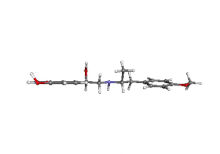Formoterol
Formoterol je organsko jedinjenje, koje sadrži 19 atoma ugljenika i ima molekulsku masu od 344,405 Da.[1][2][3][4][5][6][7]
 | |
 | |
| Klinički podaci | |
|---|---|
| Prodajno ime | Foradil, Foradile, Oxeze Turbuhaler, Oxeze Turbuhaler Foradil |
| Drugs.com | Monografija |
| Način primene | Respiratorno (inhalacija) |
| Farmakokinetički podaci | |
| Poluvreme eliminacije | 10 h |
| Izlučivanje | Renalno |
| Identifikatori | |
| CAS broj | 73573-87-2 |
| ATC kod | R03AC13 (WHO) |
| PubChem | CID 3410 |
| IUPHAR/BPS | 3465 |
| DrugBank | DB00983 |
| ChemSpider | 3292 |
| KEGG | C07805 |
| ChEMBL | CHEMBL1363 |
| Hemijski podaci | |
| Formula | C19H24N2O4 |
| Molarna masa | 344,405 |
| |
| |
Osobine
уреди| Osobina | Vrednost |
|---|---|
| Broj akceptora vodonika | 5 |
| Broj donora vodonika | 4 |
| Broj rotacionih veza | 8 |
| Particioni koeficijent[8] (ALogP) | 1,9 |
| Rastvorljivost[9] (logS, log(mol/L)) | -4,4 |
| Polarna površina[10] (PSA, Å2) | 90,8 |
Reference
уреди- ^ Bartow RA, Brogden RN: Formoterol. An update of its pharmacological properties and therapeutic efficacy in the management of asthma. Drugs. 1998 Feb;55(2):303-22. PMID 9506248
- ^ Cheer SM, Scott LJ: Formoterol: a review of its use in chronic obstructive pulmonary disease. Am J Respir Med. 2002;1(4):285-300. PMID 14720051
- ^ Steiropoulos P, Tzouvelekis A, Bouros D: Formoterol in the management of chronic obstructive pulmonary disease. Int J Chron Obstruct Pulmon Dis. 2008;3(2):205-15. PMID 18686730
- ^ Faulds D, Hollingshead LM, Goa KL: Formoterol. A review of its pharmacological properties and therapeutic potential in reversible obstructive airways disease. Drugs. 1991 Jul;42(1):115-37. PMID 1718682
- ^ Op't Holt TB: Inhaled beta agonists. Respir Care. 2007 Jul;52(7):820-32. PMID 17594727
- ^ Knox C, Law V, Jewison T, Liu P, Ly S, Frolkis A, Pon A, Banco K, Mak C, Neveu V, Djoumbou Y, Eisner R, Guo AC, Wishart DS (2011). „DrugBank 3.0: a comprehensive resource for omics research on drugs”. Nucleic Acids Res. 39 (Database issue): D1035—41. PMC 3013709 . PMID 21059682. doi:10.1093/nar/gkq1126.
- ^ David S. Wishart; Craig Knox; An Chi Guo; Dean Cheng; Savita Shrivastava; Dan Tzur; Bijaya Gautam; Murtaza Hassanali (2008). „DrugBank: a knowledgebase for drugs, drug actions and drug targets”. Nucleic acids research. 36 (Database issue): D901—6. PMC 2238889 . PMID 18048412. doi:10.1093/nar/gkm958.
- ^ Ghose, A.K.; Viswanadhan V.N. & Wendoloski, J.J. (1998). „Prediction of Hydrophobic (Lipophilic) Properties of Small Organic Molecules Using Fragment Methods: An Analysis of AlogP and CLogP Methods”. J. Phys. Chem. A. 102: 3762—3772. doi:10.1021/jp980230o.
- ^ Tetko IV, Tanchuk VY, Kasheva TN, Villa AE (2001). „Estimation of Aqueous Solubility of Chemical Compounds Using E-State Indices”. Chem Inf. Comput. Sci. 41: 1488—1493. PMID 11749573. doi:10.1021/ci000392t.
- ^ Ertl P.; Rohde B.; Selzer P. (2000). „Fast calculation of molecular polar surface area as a sum of fragment based contributions and its application to the prediction of drug transport properties”. J. Med. Chem. 43: 3714—3717. PMID 11020286. doi:10.1021/jm000942e.
Literatura
уреди- Hardman JG, Limbird LE, Gilman AG (2001). Goodman & Gilman's The Pharmacological Basis of Therapeutics (10. изд.). New York: McGraw-Hill. ISBN 0071354697. doi:10.1036/0071422803.
- Thomas L. Lemke; David A. Williams, ур. (2007). Foye's Principles of Medicinal Chemistry (6. изд.). Baltimore: Lippincott Willams & Wilkins. ISBN 0781768799.
Spoljašnje veze
уреди
| Molimo Vas, obratite pažnju na važno upozorenje u vezi sa temama iz oblasti medicine (zdravlja). |